Journal of
eISSN: 2574-9943


Research Article Volume 8 Issue 2
Aesthetic Doctor, Sport Medicine, Pretoria, South Africa
Correspondence: Riekie SMIT MD, Aesthetic Doctor, Sport Medicine, Pretoria, South Africa
Received: May 30, 2024 | Published: June 14, 2024
Citation: Riekie S. Evaluation of the efficacy of a TCA medium peeling procedure combined with skin biorevitalization in face rejuvenation: a case series. J Dermat Cosmetol. 2024;8(2):35-39. DOI: 10.15406/jdc.2024.08.00262
Background: Aging is triggered by both intrinsic and external factors. Although chemical peels with trichloroacetic acid (TCA) are used to reduce wrinkles and hyperpigmentation, they cannot help to enhance the other factors that contribute to overall skin quality.
Objective: The aim of this case series was to compare the efficacy of 15% TCA peel alone versus a combination of NCTF®135HA injection and 15% TCA for face rejuvenation.
Methods: Six patients were treated on each side of their face with 15% TCA combined or not with NCTF®135HA. Each patient was subjected to one session of peeling on both sides of the face followed by three sessions of NCTF®135HA injections, on only one randomized side of the face, with an interval of two weeks between each treatment. Skin aging measures were assessed before and after treatments (D0 and D45).
Results: At D45, clinical scoring demonstrated a significant difference in reducing the lower face sagging score, increasing skin hydration, and improving skin homogeneity on the side treated with NCTF®135HA combined with peeling compared to the side treated with peeling alone. There is a tendency for improvement in Crow’s feet only on the side treated with both peeling and NCTF®135HA, compared to the side treated with peeling alone. Both the evaluator and the patient reported a greater improvement on the side of the face treated with 15% TCA + NCTF®135HA on the Global Aesthetic Improvement Scale (GAIS).
Conclusions: The addition of NCTF®135HA to 15% TCA chemical peel application significantly enhanced the peeling effect on skin aging features, this improvement was perceived by both subjects and the physician.
Aesthetic medicine is defined by medical procedures aiming at physical improvement at the patient's request. Its main indication regards the management of skin ageing, whether it is preventive, corrective or in addition to surgery, in order to preserve the youthfulness of the skin and reduce the signs of ageing.1
The process of ageing is complex and multifactorial, affecting not only the skin but also the bone architecture and the subcutaneous tissues (fat, muscles, tendons).2 It is defined as a process involving intrinsic and extrinsic mechanisms. Intrinsic ageing is highly related to chronological age and genetic factors aggravated by free radicals and hormonal influences. Extrinsic ageing is a distinct process caused by external factors such as UV exposure and the individual lifestyle (tobacco, pollution, nutrition).3–5
Unlike cosmetic surgery, which consists of invasive procedures performed by a surgeon, aesthetic medicine includes superficial, non-invasive procedures that are performed on an ambulatory mode and for which the results are obtained rapidly or even immediately, without social eviction. These non-invasive techniques are therefore increasingly attractive. A study published in 2018 showed that the primary motives, apart from skin ageing was health protection (53%), psychological well-being (69.3%), and improvement of comfort and confidence in social situations (56.6%).6
Various techniques at the forefront of innovation have proved their value: hyaluronic acid, threads, botulinum toxin injection, peeling, laser. Furthermore, in recent years, we observed a shift toward an improved understanding and appreciation of the three-dimensional aspects of skin aging.1,7 In order to achieve the most natural and effective face rejuvenation, multiple improvements must be completed at once, which requires the usage of more than a single procedure or agent.7–9
However, it is critical to examine how multiple aesthetic interventions can be combined safely and effectively.10
In this study, we propose to evaluate the combining effect of a medium-depth peeling with a biorevitalizing procedure.
Peeling is a regenerative exfoliation technique aiming to rejuvenate the superficial surface of the skin by efficiently removing aged skin, replacing it with newer, smoother and more fine-looking skin, through a chemically abrasive procedure.11,12
The medium-depth peel will act on the middle layers of the skin by penetrating as far as the papillary dermis by eliminating the epidermal layer and the upper part of the dermis.
The active ingredient of this peel is trichloroacetic acid (TCA), used in different concentrations generally between 15 and 30%. Here, we used a 15% concentration.
This type of peeling is indicated in the correction of spots and deep wrinkles. It also acts on fine lines, dilated pores and skin slackening.13
Anti-aging biorevitalization, or polyrevitalization, is a technique widely used in the aesthetic field because of its gentle and global action, not only on the consequences of skin ageing but also on its causes. It consists in multiple injections into the superficial dermis using very fine needles. Very small quantities of hyaluronic acid and with a cocktail of nutrients essential to the cellular environment are introduced as close as possible to the cells of the dermis in order to stimulate the regeneration of the dermis.14
In this study, we chose to investigate the synergistic efficacy of a 15% TCA peeling procedure with NCTF®135HA, a polyrevitalizing complex consisting in vitamins, amino acids, minerals, coenzymes, nucleosides and antioxidants, combined with hyaluronic acid for its hydrating and plumping properties. This will help to restore an optimal environment for cells and to stimulate the biosynthetic ability of fibroblasts, stimulating an increase in collagen and elastin productions to help restructuring mature skin.14–16
The result expected from this combination is a long-lasting and enhanced action of the biorevitalizing and peeling procedures. Specifically, the peeling procedure will be carried out to eliminate dead skin cells and optimize penetration of the biorevitalizing cocktail into the skin.
Yet, studies examining the benefits of combining these two techniques on human skin are lacking and the efficacy and safety of such a therapeutic strategy are poorly documented. Thus, the aim of this study is to demonstrate the rationale of a combination approach, suggesting that two techniques act better than a single treatment to recover facial aging and to improve skin aspect and quality.
In this study, we propose to evaluate the synergistic effect of combining the NCTF®135HA biorevitalizing technique with a TCA peeling.
Patients
Six patients from 38 to 59 years old (median age 46), 4 women and 2 men have been evaluated in this case report. All of the patients were healthy, with no history of surgical or non-surgical procedures to improve skin quality and they accepted through a written consent to be treated unilaterally (split face manner) for 3 sessions after TCA peeling. 2 months after the end of evaluation period, the other side of the face has been treated as well in order to avoid any asymmetry.
Procedure
The study was conducted over a period of 6 weeks. To compare the efficacy of TCA peeling alone or in combination with NCTF®135HA on the same patient, both sides of the face were treated with 15% TCA peeling while only one side was injected with NCTF®135HA. Three injection sessions were conducted at D0, D15 and D30 by NCTF®135HA while the TCA peeling was performed only at D0 (Figure 1).
Criteria for efficacy evaluation
The evaluator conducted a complete assessment of each patient. Various parameters were measured to determine treatment efficacy: intensity of crow’s feet wrinkle, nasolabial folds, ptosis of the lower part of the face, skin radiance, skin hydration, skin firmness, and skin homogeneity by clinical scoring scale.
Assessments included visual evaluation and clinical scoring. All procedures were photographically documented.
Patients were assessed at Day 0 (before treatments) and at Day 45. The crow’s feet wrinkles, nasolabial folds and ptosis of the lower part of the face were done according to Bazin scale.17
The other clinical scoring was performed on a 9-scale base scoring system (0 = none, 1-3 = light, 4-6 = moderate, 7-9 = important) for skin homogeneity, hydration, and firmness. In addition, clinical scoring of skin radiance was based on four scales scoring system as follows: 0=very dull skin, 1=dull skin, lacking radiance, 2=slightly radiant skin, 3= radiant skin, 4= very radiant skin.
Instrumental assessments were conducted using the VISIA skin analysis system (Canfield, US) based on the image analysis. Outcomes were assessed at D0 and D45. The satisfaction rate was evaluated by physician and the subjects based on the GAIS (Global Aesthetic Improvement Score) on a 7-point scale from "very much improved" to "very much worse". The improvement scale with reference to the pre-injection aging grade was assessed independently by both subjects and physician at D45.
Statistical analysis
Although the number of subjects is limited, for all quantitative data, the mean and median were determined. The student t-test was utilized for comparative analysis.
Clinical scoring of crow’s feet wrinkles, ptosis of the lower part of the face and firmness
At baseline (Day 0), the mean crow's feet wrinkle score (Bazin crow's feet scale) (Table 1) for both sides of the face were 2.6. This value decreased to 1.3 with a significant tendency on the side treated with TCA and NCTF combination (p value=0.06), but not on the side treated with TCA alone (NS) (Figure 2).
|
Bazin Crow’s Feet Wrinkle Scale |
|
|
Grade |
Description |
|
0 |
No wrinkle |
|
1 |
Very shallow, still visible wrinkle |
|
2 |
Shallow wrinkles |
|
3 |
Slight wrinkles |
|
4 |
Mild wrinkles |
|
5 |
Deep wrinkles |
|
6 |
Very deep wrinkles |
Table 1 Bazin Crow’s feet wrinkle scale
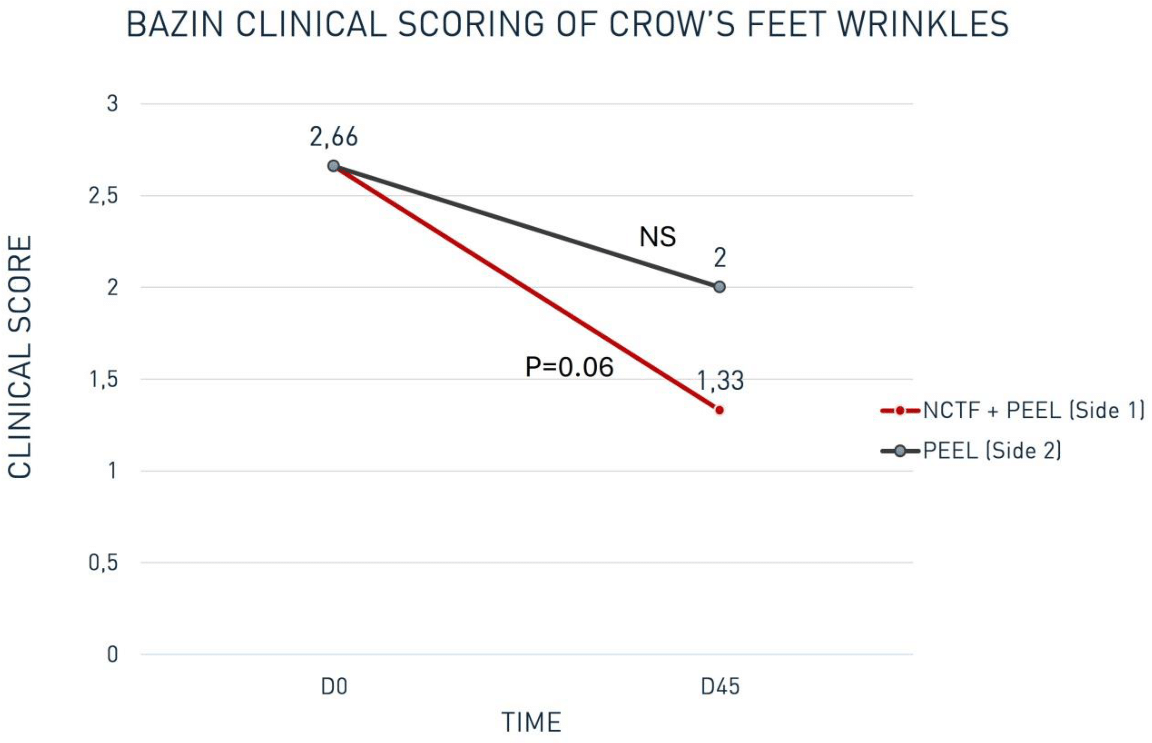
Figure 2 Evolution of mean crow’s feet wrinkle score (Bazin scale) from D0 to D45 after 3 sessions of intradermal injections of NCTF®135HA combined with one session of 15% TCA versus one session of 15% TCA alone.
In terms of facial contour sagging, the Bazin score was significantly lower on both sides of the face at day 45 (0.37 at Day 45 versus 2.37 at baseline for the side treated with combination; p<0001). The score for the other side treated solely with TCA decreased to 1.62 at day 45 compared to 2.37 at baseline (p=0.03)]. The evolution of the two sides of the face differed significantly (p=0.001) (Figure 3).
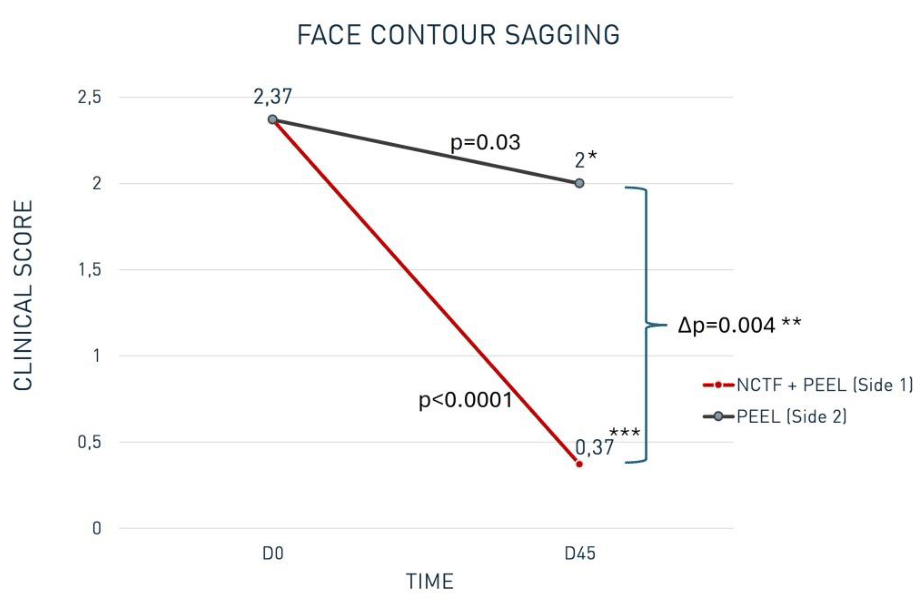
Figure 3 Evolution of mean face contour score based on Bazin scale from D0 to D45 after 3 sessions of intradermal injections of NCTF®135HA combined with one session of 15% TCA versus one session of 15% TCA alone.
Significant: * p < 0.05, *** p < 0.001.
A 9-scale clinical scoring system was utilized to assess skin firmness. The results showed a significant improvement in skin firmness on the side treated with TCA and NCTF (6 at day 45 against 4 at baseline, p value=0.03), but not on the side treated with TCA alone (4.8 at day 45 versus 4 at baseline, p=0.3).
Clinical scoring of skin quality
Overall, all patients showed a global improvement in their skin quality parameters after objective consideration.
Hydration: In comparison to 15% TCA alone (mean score of 4.7 at day 45, evolution NS, delta D45-D0 of 1.2 scores), the mean hydration score increased significantly only on the face-side treated with 15% TCA and NCTF®135HA from D0 to D45 (mean score of 5.8 at day 45, significative evolution with p=0.0026, delta D45-D0 of 2.3 points (Figure 4).
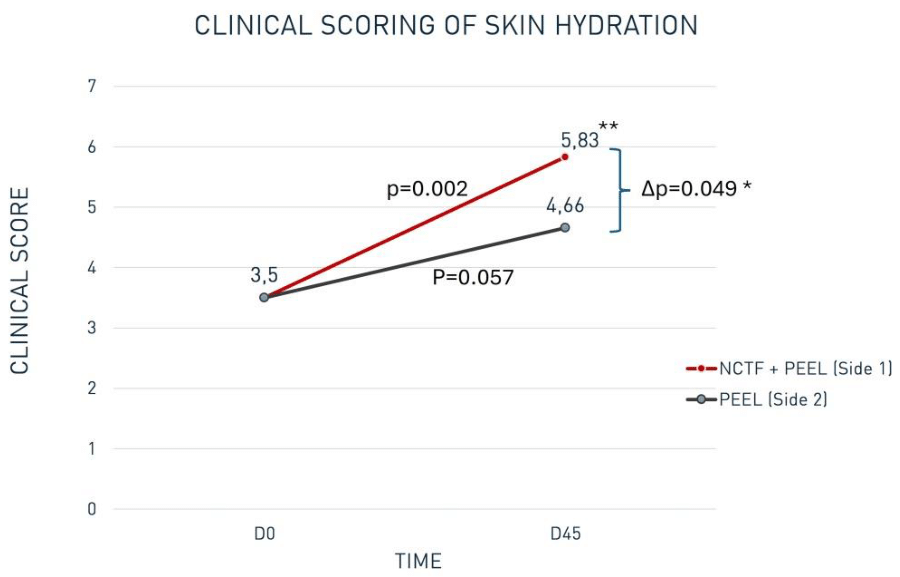
Figure 4 Evolution of mean skin hydration scores from D0 to D45 after 3 sessions of intradermal injections of NCTF®135HA combined with one session of 15% TCA versus one session of 15% TCA alone.
Significant: * p < 0.05, *** p < 0.001.
Skin firmness: Differences between the skin's firmness before and after treatment with 15% TCA alone did not reach statistical significance. In comparison, the other side of the face that had been treated with 15% TCA + NCTF®135HA showed a significant delta of 2 points between D45 and baseline (D0) (p=0.003) (Figure 5).
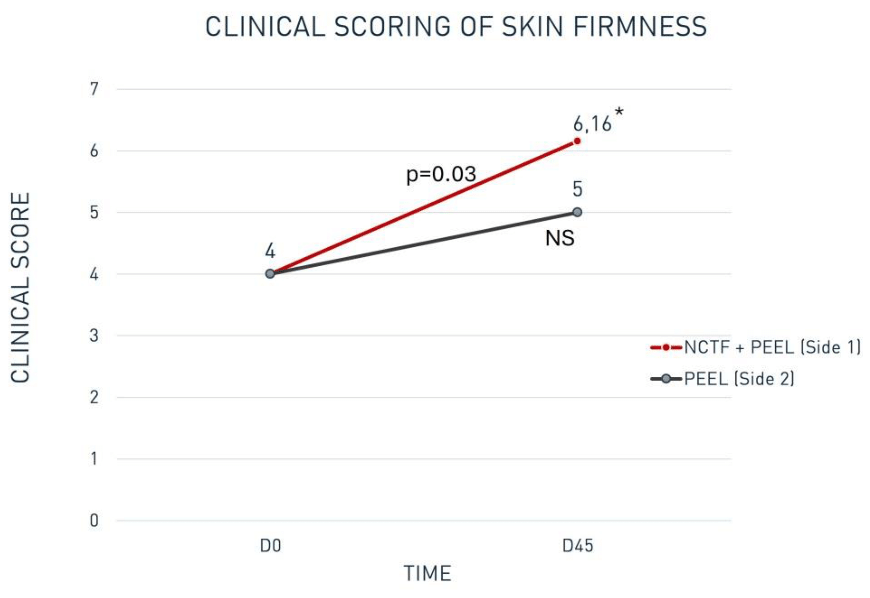
Figure 5 Evolution of mean skin hydration scores from D0 to D45 after 3 sessions of intradermal injections of NCTF®135HA combined with one session of 15% TCA versus one session of 15% TCA alone.
Significant: * p < 0.05, *** p < 0.001.
Skin Homogeneity was remarkably improved on both treatment sides (peeling with and without NCTF®135HA) However, this improvement was significantly much greater on the face-side treated with the combination of 15% TCA + NCTF®135HA versus peeling alone (p=0.02) (Figure 6).
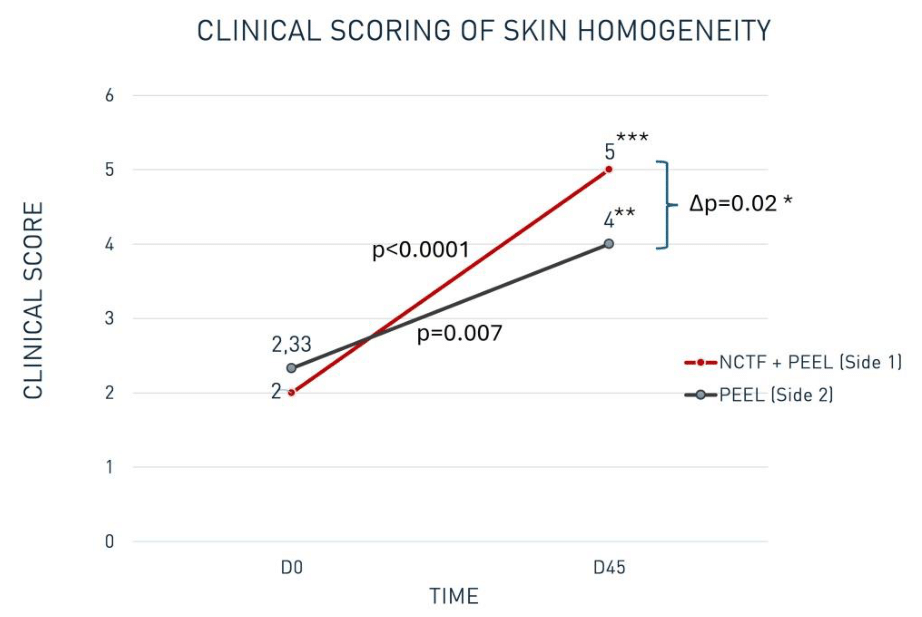
Figure 6 Evolution of mean Skin homogeneity score from D0 to D45 after 3 sessions of intradermal injections of NCTF®135HA combined with one session of 15% TCA versus one session of 15% TCA alone.
Significant: * p < 0.05, *** p < 0.001.
Skin radiance: There was a notable improvement on both treatment sides, peeling with and without NCTF®135HA (p=0,001 and p=0,01 respectively). No significant difference was noted between the two sides (results not shown).
GAIS scoring
Treatment efficacy was assessed using the Global Aesthetic Improvement Scale (GAIS) by both participant and physician at D45 (Table 2).
|
GAIS (Global Aesthetic Improvement Scale) Scoring |
|
|
Score |
Grade |
|
3 |
Very much improved |
|
2 |
Much improved |
|
1 |
Improved |
|
0 |
No change |
|
-1 |
Worse |
|
-2 |
Much worse |
|
-3 |
Very much worse |
Table 2 GAIS (Global Aesthetic Improvement Scale) Scoring
After objective examination, as shown in Figure 7, the physician reported mean scores on the GAIS of 2,5 (much improved, p< 0.001) on the side of the face treated with 15% TCA + NCTF®135HA compared to the side of the face treated with 15% TCA alone (mean score of 1.16 (improved), p< 0.001).
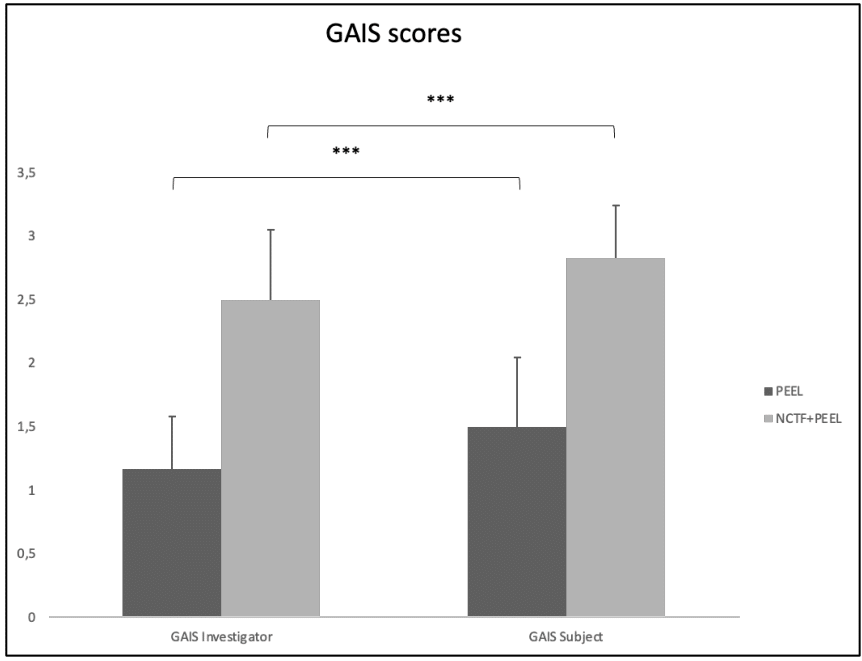
Figure 7 Physician and patient Global Aesthetic Improvement Scale (GAIS) ratings at D45 after 3 sessions of intradermal injections of NCTF®135HA combined with one session of 15% TCA versus one session of 15% TCA alone.
Significant: * p < 0.05, *** p < 0.001.
Similarly, patients reported significant improvement on both sides of their face. This improvement, however, achieved a score of 2.8 for the side of the face treated with the 15% TCA + NCTF®135HA combination, and only 1.5 for the side of the face treated with peeling alone (Figure 6).
Skin rejuvenation research is continually evolving to identify innovative techniques that can deliver more effective results.
Chemical peels, which employ a variety of chemical agents, are one of the most commonly utilized cosmetic methods. It has been shown to improve the appearance of several skin conditions such as acne, melasma, photodamage, and skin rejuvenation. TCA is the mainstay for chemical peeling agents. It has been studied extensively and has the advantage of producing superficial, medium-depth, and deep peels.1,13,18–21
As research into rejuvenation treatments progresses, the efficacy and safety of TCA peeling are increasingly being examined clinically in direct comparison with other therapies.
TCA in combination with other cosmetic procedures has also been studied, with the potential for synergistic treatment and greater flexibility in adapting therapies to specific patient demands and situations. It has been investigated in skin rejuvenation methods in combination with other techniques such as botulinum toxin injection or ablative carbon dioxide laser. It has also been mixed with other peeling agents like phenol, Jessner solution, or topical vitamin C.22–25
Although TCA treatment can improve photodamage, hyperpigmentation and fine wrinkles, a superficial peel cannot resolve all the parameters associated with aging, namely hydration and overall facial firmness.
In combination with NCTF®135HA treatment, a complete result can be achieved without having to resort to an excessively deep peel, thus limiting undesirable effects and ensuring greater patient acceptance.
According to our findings, both combination and control treatments showed a statistically significant improvement of aging parameters. However, the combined modality of 15% TCA + NCTF®135HA improved skin hydration and skin firmness while statistical significance was not achieved with the 15% TCA peel alone. Furthermore, the combination approach appeared to improve crow’s feet wrinkles, skin homogeneity to a greater extent than the peeling alone.
These findings suggest that the combination therapy is more effective than TCA peel alone. This synergistic effect could be explained by the peeling procedure's ability to clear dead skin cells and optimize the penetration of the biorevitalizing cocktail into the skin.
Here, we report the outcomes for six patients. However, we hypothesize that a larger sample size would confirm the observed trends and the significant improvement associated with the addition of NCTF®135HA to a chemical peel.
This study demonstrates the effectiveness of combining TCA with NCTF®135HA treatment on skin quality features. Both combination and control treatments significantly improved aging parameters; however, the combined modality of 15% TCA + NCTF®135HA showed superior improvements in skin hydration, skin sagging and skin homogeneity compared to 15% TCA peel alone. The enhanced effectiveness of the combination therapy likely stems from the peeling procedure's ability to clear dead skin cells, and the capacity of NCTF®135HA to provide all the ingredients the skin needs to improve its quality. Although our findings are based on a small sample size, we hypothesize that a larger cohort would further validate the significant benefits observed with the addition of NCTF®135HA to a chemical peel.
None.
The author declares no conflict of interest.

©2024 Riekie. This is an open access article distributed under the terms of the, which permits unrestricted use, distribution, and build upon your work non-commercially.